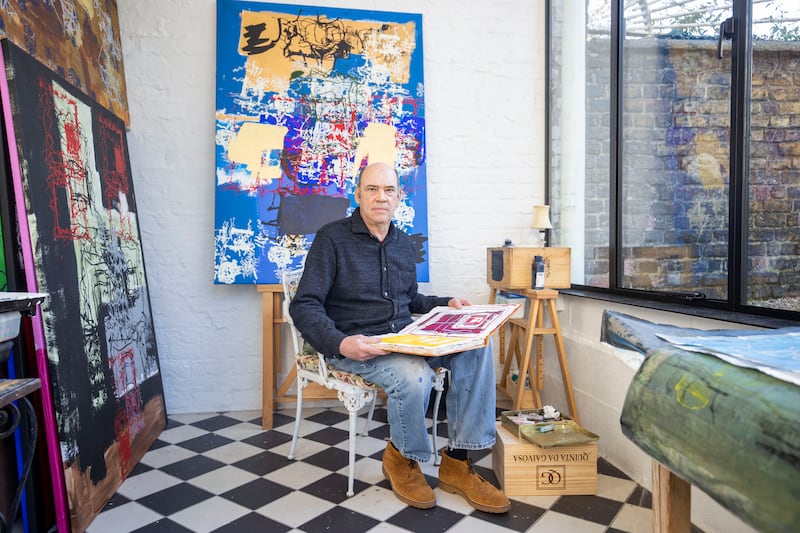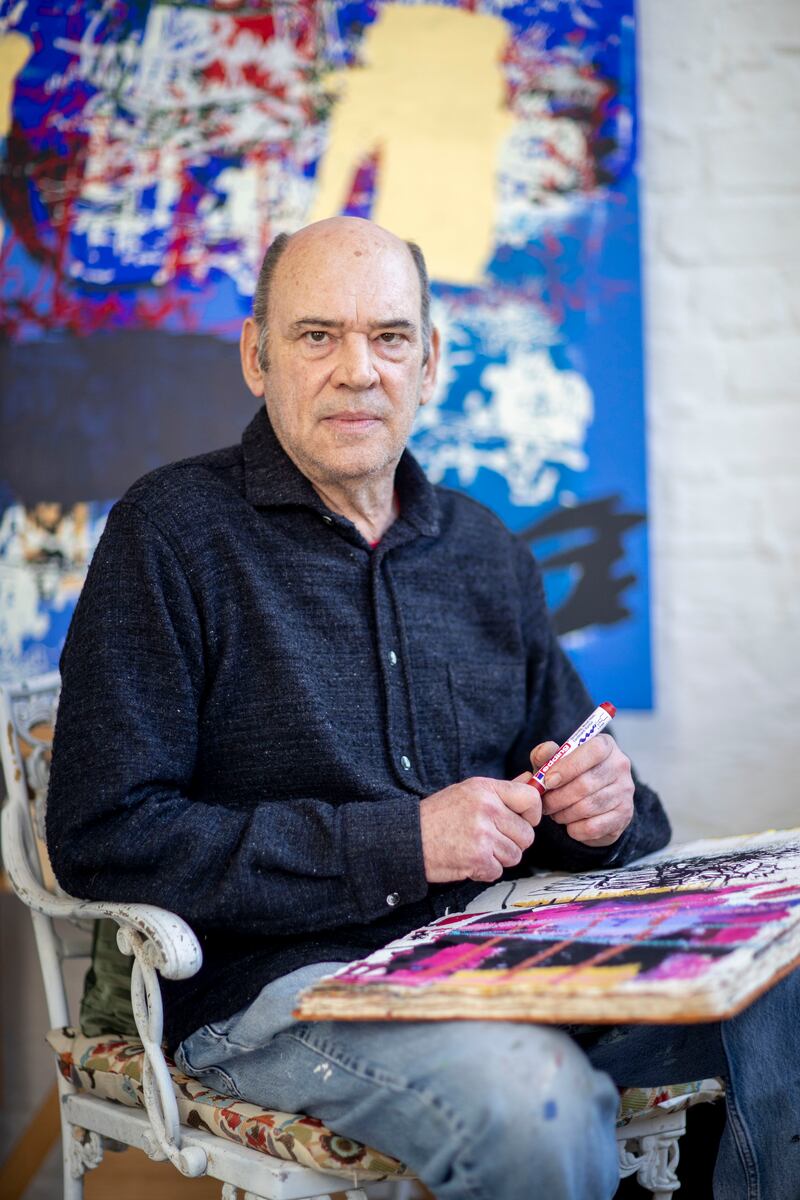Sitting in the basement of his house on leafy Pembroke Road in Dublin, surrounded by dozens of expressionist canvases, the artist Brian Gormley could scarcely be further removed from the grimy streets and subways of New York, where he made his first forays into art.
After graduating from Cornell University in the early 1980s, he settled in the East Village, then a lively artistic hub of painters, film-makers and musicians. “It was like Paris at the turn of the century,” he recalls, reeling off names like the Ramones, Deborah Harry and Grandmaster Flash. “Everywhere you went you were inspired, and felt you were part of something.”
It was the street art that attracted Gormley, at a time when trained artists were leaving studios to add their tags to the colourful confusion outdoors. His tag was a volcano going around a roller coaster, which he daubed on abandoned building lots for about six months.
“It was bright, done very quickly with spray cans, and it was kind of rebellious,” the now 63-year-old says of the graffiti of that era. “It went over advertising and was considered defacement, a crime.”
Gormley was eventually caught by the police – red-handed as it were. “They saw the evidence on my hands from a spray can, and they said, ‘Aren’t you a little too old to be doing this?’ And because I was white they let me go. If I was black they would probably have killed me. It was a very racist time in the States. Still is.”
What Gormley is alluding to is the death in 1983 of Michael Stewart, an African-American arrested for putting graffiti on a subway wall and who died after being allegedly mistreated by police. The death was memorialised by Jean-Michel Basquiat, both a friend and profound influence on Gormley, in the work Defacement.
The flare of expressionism that lit up the art scene in the 1980s soon faded. “It lasted from 1980 to 1988, and died with the junk-bond market,” Gormley says. “Then you had the likes of Jeff Koons, and all of a sudden ‘smart art’ was back. Intellectualism was in, expressionism was out. I was just getting revved up by the time the new movement came in, [so] I kept going with what I was doing.”

As the curator Mara Williams wrote in 2007, Gormley was one of the very few artists, along with Basquiat, who made the transition from street- to studio-based work “in a way that most urban graffitists were unable to do … retaining the energy and pulse of the street [while] drawing on a refined visual sensibility, on rigorous training of their arms, hands and eyes, and on knowledge of the history of art and culture…”
Though he had solo exhibitions in New York, Zurich, Madrid and Dublin, Gormley was never signed up by one of the top US galleries, partly because he refused to play the game. “I held on to what I believe in. So many artists would change with the time,” he says. “Whatever the galleries were showing, they would say, ‘Oh, I am going to gear towards that.’” But he also admits to being uncontrollable, a bit difficult.
“I was a wild man,” he agrees. “I was a heavy drinker, smoked a lot of pot. I played the drunken Jackson Pollock, driving around in a pick-up truck drinking a case of beer. Picasso said every artist lives every other artist’s life until he finds his own way. So I played that role, but it was an act.”
He never stepped over the line into self-destruction, as Basquiat did, dying in 1988 at the age of 27 from a heroin overdose. When visiting his apartment, Gormley saw used needles in the bathroom but never dabbled with heroin himself. “A lot of artists really wanted to martyr themselves, as if it added a quality to their work. I was never ready to martyr myself to that level,” he says. “When Jean-Michel tried to sober up, they’d say, ‘You were much better when you were high.’ He was used, and he was lonely. In one of the last conversations I had with him he said, ‘Brian, I am all alone. People just use me. They come to the apartment and want to know what cereal I eat, or what kind of paint I use. It’s like I’m not a real person.’”
Gormley was in Dublin, awaiting Basquiat’s promised arrival, when word came through of his death. The artist’s introduction to Ireland had been through his father, Edward Francis Gormley, whose parents were born in Longford and Mayo, and who sounds like the protagonist of a William Boyd novel. A B17 pilot who flew 35 missions over Germany and who parachuted into Cherbourg to train the French Resistance, Edward F Gormley was also a novelist, and his play In Search of Michael Collins was staged at the Royal College of Surgeons.
His parents “left me here in 1982″, Brian Gormley recalls, so he went to work for the printmaker Seán Ó Murchú, who operated a studio on the top floor of the Powerscourt Centre in Dublin. Ó Murchú did small editions of prints for leading Irish artists, and Gormley soon met the likes of Brian Maguire, Charlie Cullen and Mick Cullen. Afterwards he spent summers in Dublin, and exhibited at the RHA and other galleries.
Now he’s here to stay. Gormley’s mother died in 2020, after he nursed her for two years, leaving him with no reason to stay in the United States. “I like Ireland, because it has a moodiness, a melancholy,” he says. “The ancient world is still alive here. In Ireland everyone gets a chance, because there’s a lot of support for the arts. What you do with that support is up to you. I feel a real love and appreciation here. I have a ‘simpatico’ to the country, its pacing, the way of life. I feel like I belong. I can relax.”
The house on Pembroke Road is an inheritance, and Gormley has spent the past few months moving his personal collection of paintings, some quite large, into its basement. “Moving was huge. I just took the best of everything I had,” he says. “I’m slowly unpacking things. It’s like Christmas. I need certain pieces around to inform me.”
He has also found inspiration in the ancient markings at Newgrange, the graffiti of its day. He once did a piece of performance art at Skara Brae, in the Orkney Islands, wrapping the standing stones with paper. He did a close study of the layers of markings – first the ancient Neolithic carvings, then the crusader’s cross left by marauding12th-century Norsemen, right up to the “Joey loves Sally” scratchings of the 1950s.
“My work is like that – layers of markings,” he says. “Some canvases I have been working on for 10 or 15 years. It’s like a diary of different movements coexisting on the same plane. Life changes you. Sometimes I have to live a little longer to finish a painting. It’s not like, ‘Oh, I have to finish it because they’ll be coming along to pick up this work for the next show.’”
Like Pollock, another influence, Gormley is a physical painter, still working with canvases on the floor even as some of his contemporaries create iPad art or NFTs. The former Irish Times art critic Brian Fallon once wrote that he had evolved “a complex technique which incorporates the use of silk screening as well as paint, and builds up his pictures gradually through an athletic balance of intuition and a skill verging on virtuosity”.

Gormley likens his technique to boxing – going left, right, back, jabbing around the canvas. “It has that speed of execution too,” he says. “You’re working but you’re not thinking. There’s an automatic pilot, like a state of grace, and it’s exhilarating. Almost like speaking in tongues, because something comes over you. It’s like a spirit working through you, if you allow it. You don’t get that in life-drawing class…”
He still studies graffiti, taking pictures of it as he walks around Dublin, noting the colours, but is dismissive of its current iteration. Graffiti has become homogenised, he believes, all learned from books. “Graffiti artist” is a career choice.
“You go to the store now to buy spray cans. Back then the kids stole it and used razor blades to get different effects, and people got killed on the tracks to do it. Now they are out playing with their parents’ money.”
When he was an art teacher Gormley would explain to students how to progress from graffiti to a more sophisticated style, as he did, “how the energy can be translated”. One of them got it, and now works as a graphic artist. “Reaching one was good,” he says, smiling.





